Home > Learn to ring > Your first lesson
Bellringing has its own very strange language with which everyone is familiar… except you. For new recruits who don’t yet speak fluent bellringer, this can be quite mysterious! Who are Bob and Sally and what is whipping? So, here is your guide to some of the things you might see and hear during your first lesson.
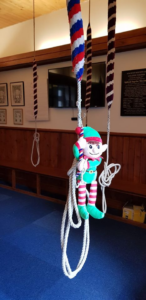 Sally
SallyThe sally is the fluffy woollen bit on the rope. Sallies come in all sorts of interesting colours. The Christmas Elf is holding onto the rope just below the sally.
The tail end is the bottom end of the rope.
When the bell is not being rung, the rope is tied into a special knot so that people don’t accidentally trip over it. You’ll be taught all about “Elf and Safety” during your first lesson.
When you make the bell ring using the sally.
When you make the bell ring using the tail end.
When you make the bell sound combining the handstroke and backstroke with the bell up.
A bell can be up or down and you can stand it, chime it and hold it on the balance. It’s important to appreciate when a bell is up or down as it has some very important safety implications if you get it wrong. Don’t ever assume.
The bell is usually left down in-between lessons or practices, but don’t rely on this. You will be taught how to safely check whether a bell is up or down during your first lesson.
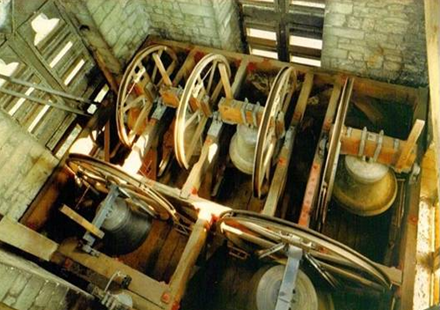
The bell is in the safe position with the mouth (the widest bit) at the bottom.
When you make the bell sound when it is down.
With the bell down and swinging but not sounding, you catch the bell to make it sound once.
The bell is usually left up during a practice session. This position can be dangerous, so be careful when the bell is in the up position and only do as your teacher instructs.
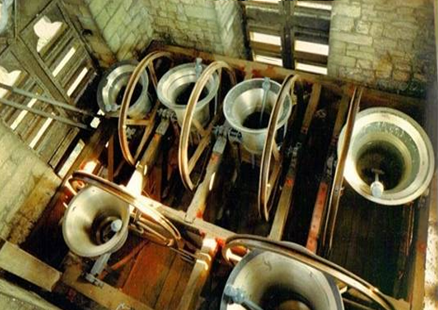
The bell is in the dangerous position with the mouth at the top.
When the bell is up and at rest against the stay.
With the bell up, holding it so that it isn’t set but just about to pull off.
To make the bell start its full-circle swing.
The english style of bellringing is often called full-circle ringing, as the bell’s connection to the wheel allows it to rotate 360 degrees. A ringer must pull the bell at each stroke to make it rotate again for another full circle swing. Each time the ringer pulls the rope the bell swings and sounds. The bell sounds when the clapper hits the inside of the bell near the end of each stroke, so the sound is not produced at the same time as the rope is pulled. In change ringing, it is possible for the bellringers to adjust the time at which they pull their rope to control the speed of striking in order to produce the pattern of changes.
The accompanying slow motion video was recorded at St. John’s Cathedral, Brisbane. The animation shows the position of the bell taken from a sensor attached to the bell wheel.
Ringing is harder than it looks and you won’t be expected to ring a bell independently by the end of your first lesson. On average it takes 10 to 15 hours of intensive instruction to be able to ring a bell safely and competently, keeping your bell in time with others.



In her own words…
I learned to ring at the age 42, after my sister started ringing a few years earlier at her local tower in the Cotswolds. At first I couldn’t understand why we had to find out when the local churches were ringing during family holidays, but since I started ringing, we are now finally on the same page!
I was quite a quick learner when it came to bell handing but was advised on a course a few months later that my handling wasn’t right and I needed to count my place and not just learn the numbers. It was a breakthrough moment when it all became clear and I then turned my attention to other new ringers who had been in the same situation as me just a few months before.
Someone mentioned ART to me a few years later and I went on a Module 1 course in 2018. It provided me with all the tools to start teaching and I was keen to get started straight away. I taught my first learner in 2019 and soon after Covid stuck. Not to be deterred, I started again in 2022 with two new ringers and when more people wanted to learn, I encouraged other experienced ringers at my tower to attend a Module 1 course. Ringers from surrounding towers have also attended the course and we now have an active group of teachers and new ringers within a few miles of each other.
Being a mentor has provided me with further experience and I find that every new ringer, has something new to teach me too.
Having come to ringing later in life, I find it easy to relate to new ringers struggles. Seeing them succeed has been a great achievement.
I am an Operations Coordinator for a large high street retailer and in my spare time I like exploring areas of historical interest and natural beauty in my spare time. I am also a keen hill and mountain walker.

In her own words…
‘I learned to handle a bell as a teenager because I was intrigued, and it was the best ‘after-school’ club on offer. College, and then working in Tennessee where, at the time, they had no bells meant a 5-year hiatus from ringing. It wasn’t until I mentioned in passing at a University evening meeting that I had done some ringing that half an hour later I found myself at a practice night not far from York, and by the end of the evening had remembered how to plain hunt – sort of.
My first foray into serious teaching was in 1999 when I became heavily involved in teaching two brand new bands in time to ‘Ring in the Millennium’, and teaching has really been my focus ever since. I find it both challenging and rewarding, and as much a learning experience for me as it is for the person I am teaching. I went on one of the first M1 and then M2 courses at Kineton and became an accredited member of ART in 2013′.

Awaiting biog

Phil learned to ring at the age of 11, having initially only gone to watch. This was at St Columb Major, Cornwall where he still rings and has been tower captain for almost a quarter of a century. They are primarily a call change band, some of whom also ring methods, and have taken part with some success over the years in the traditional Cornish rise-rounds-fall striking competitions. The tower is equiped with a Higby training bell connected to Abel.
After a career in IT working for Cornwall County Council, a reorganisation enabled Phil to take early retirement; the Kernow Old Codgers mid-week group soon followed. He also organises Pydar Improvers practices (affectionately known as PIMPS!) for ringers across the Pydar Deanery and beyond, and with the support of other teachers in the area recently registered the Pydar School of Bellringing as an ART Teaching Hub.
Despite having been teaching ringing for decades Phil firmly believes that there is always something new to learn, and so attended an ART Module 1 course some ten years ago. He has since also completed M2F, and in recent years has been an ART Assessor and is now an ART Tutor.

Now living in Hampshire after spending 40 years in London, Roger has held various posts within local ringing societies. For a long time Roger was a member of the Central Council of Church Bell Ringers and served on its Ringing Centres, Towers and Belfries, Redundant Bells and Administrative Committees.
As a Chartered Surveyor, Roger combined his professional career with pleasure and played a leading role in major bell restoration projects at Bermondsey. Isle of Dogs, Limehouse, Rotherhithe and Walworth, as well as many smaller projects, and the transfer of redundant rings of bells from St Stephen Ealing to Aberdeen Cathedral and Homerton to Stone next to Dartford. He therefore has a wealth of knowledge about tower maintenance issues.
To help ensure there were adequate numbers of ringers to ring these restored bells, Roger then turned his attention to issues of recruitment and training. Roger is currently a member of the ART Management Committee and an ART Tutor. He is particularly interested in initiatives to improve the quality of teaching and make more effective use of trainers through the use of simulators.

Lesley Boyle has been ringing for over forty years and has a wide breadth of experience from multi-doubles peals to peals of maximus in hand and tower. She was a participant in winning bands in the National 12 bell competition in her youth, and is now a Tower Captain teaching young and not-so-young learners. She is also local District Ringing Master, serves on the Ely Association Recruitment and Training Committee, and helps with group teaching at the local ART hub. She says “I’ve gained a lot of pleasure out of ringing over the years and want to pass this on to others. I’ve realised through teaching many people to handle that everyone benefits if they’re taught well – the learners progress more quickly and the band is supportive with less frustration. I want ART module attendees to have confidence in teaching handling and foundation skills, and get that buzz out of seeing their own learners’ achievements.”

Nick started ringing when 8 years old in a small village in north Bedfordshire. The church bells had an old oak frame, old rotting wheels and a single old ringer, with whom he chimed the five bells by tying ropes to provide foot loops. When he was 10 years old, a ringing family moved to the village, Michael and Jill Orme, and their son Phillip. Michael decided to fund raise for a new ring of six bells, and Nick was invited to learn to ring properly. By the age of 12, Nick had learned to plain hunt and ring the second to Plain Bob without the numbers, although he still remembers thinking: ‘Yes I’m doing it, but I still don’t really know what it is I’m doing’.
After university Nick’s ringing career continued in Kempston, Bedford. He was Ringing Master for a while at Kempston and for the district and rang at various local towers. Two years and a change of career later Nick moved to Leighton Buzzard, where Mark Regan was fund raising for a new ring of twelve bells. He learnt to ring on twelve and even reached the national twelve bell finals.
Nick lived in Leighton Buzzard for 35 years with his wife, Lindsay, and their two daughters, both of whom learnt to ring. They ran Linslade tower for some years and taught several young ringers towards Bedfordshire Association’s run of success in the RWNYC. After further job changes, they resettled and are now enjoying life in Rugby. All four are ART teachers and Lyndsey and Nick have been mentors since ART first began.
They have taught a new band at nearby Stretton on Dunsmore and are proud of how well they’re doing. They’re the holders of the Rugby Deanery Rounds and Call Changes cup and after two short years are learning to ring simple methods inside.
Nick has been an ART Assessor for about 5 years and is now an ART Tutor. He says that his experiences with ART have been positive, as he can see that students appreciate the way it breaks the teaching down into manageable targets.
“Bellringing is a unique and amazing hobby in many ways, it’s certainly the strangest musical instrument I know, and it produces such an iconic sound. I wish to continue to help others enjoy ringing at whatever level they are at.”

Gill learnt to ring as a teenager at a church with a single bell hung for full circle ringing! It was a few years later that she rung with others.
Involved with Scouting and young people all her life, she organised Scout and Guide visits to the tower and so began teaching many young people to ring. Young ringers camping trips followed and she became a tower grabber, open days and outings to start with, then organising her own ringing holidays and days out with other grabbers. Over 6,000 towers later she still enjoys travelling to new towers.
A member of the CCCBR Education Committee for many years she delivered the Teaching the Teachers Course. When Pip Penney a member of the same Committee proposed the forerunner to ART, Gill was keen to get involved, becoming a founder member, and with working in accounts she took on the role of Treasurer.
Gill particularly enjoys ringing quarter peals on both tower and handbells. She likes teaching all aspects of ringing and finding ways of introducing ringing to young people. She has taken the Lichfield Mobile Belfry, on four occasions, to the International Scout &and Guide Camp at Chatsworth Park, giving thousands of young people an introduction to bellringing.
Outside ringing Gill has a mentoring role in Scouting and is a keen gardener with a love of the countryside.

Frank lives in Herefordshire and rings at his home tower, Bosbury, as well as ringing and teaching in the surrounding towers where most of the teachers are ART accredited or working towards it. Frank has been involved with ART from the beginning − being part of the management team for a number of years and as a Tutor from the early days.

Christine learned to ring in 1981 at Christ Church, North Shields and it’s safe to say she was smitten from the first lesson. “How hard can it be?”, quickly became a challenge to get it right. A house move to Sunderland soon meant that she was ringing at five practice nights per week, with weddings on Saturdays and service ringing on Sundays. A wide variety of methods (and bells) as well as a keen nucleus of local ringers who took her under their wing, gave her a good grounding in basic methods as well as the chance to progress to more complex methods when appropriate.

David is an Australian ringer, resident in Brisbane but a frequent visitor to UK. He helped introduce ART to Australia and New Zealand and was one of the first antipodean ART Tutors to be appointed (2014). He is a past president of ANZAB, was a member of the ‘CRAG’ review team and then served on the Central Council Executive from 2018 to 2022. He writes ‘The Education Column’, published in The Ringing World. As a true ‘international’, he recently (Summer 2023) undertook a tour that included running eight ART modules in North America.

Kathi learnt to ring as an adult in the early 1990s at Christ Church St Laurence in Sydney, Australia. She went on to become a member of the St Mary’s Basilica Society of Bellringers in Sydney and over time have held the roles of Secretary, Ringing Master, Vice Captain, Tower Captain and Treasurer of the St Mary’s Society. She has also acted as Ringing Master at St Paul’s Burwood and St James’ Queens Square.
She has been actively involved as a helper and session leader at the annual Sydney Ringing School for many years. She has held the roles of Secretary, Newsletter Editor, and Education & Training Officer in the local branch of ANZAB.
In her first stint as Education & Training Officer, she was responsible for the E&T needs of 11 towers across NSW, with travelling distances of almost 500 km north, 500 km south and almost 600 km south-west of Sydney! A great way to see the country and meet all the regional ringers.
Currently she lives in the Blue Mountains where she is using Learning the Ropes to teach a new local band from scratch at St Hilda’s Katoomba and ringing as a member of the Lithgow Bellringers. She is now Education & Training Officer (West) with a much more reasonable travel range of only 160 km!

Les learnt to ring as an early teenager at Bournemouth and developed his ringing with the Oxford University Society with whom he rang his first peals.
He moved to Tiverton in 1981 and has been captain at St Peter’s, a fine Taylor ring of 8, at various times. He is active in the local N E Branch of the Devon Guild, being their current Ringing Master. He is also the Librarian of the Guild. In the past he was a member of the Central Council for 15 years, a member of the Ringing Centres Committee and Secretary of ART.
Currently he is a Trustee of ART with responsibility for governance, an ART Tutor and a tutor and trustee for his local Troyte Ringing Centre.

Judith learned to ring at Leeds University as a student, making rapid progress with a good band.
Her career took her to Nottingham where she rang at St Mary’s and then to South Wales ringing at Llandaff Cathedral. The past 35 years have mainly been spent in Dunblane, with a few years in the south of France (great fun but a barren time for ringing!) Judith has been Tower Captain at Dunblane since 2005 and is the Training Officer for the Scottish Association of Change Ringers. She met her husband Chris at University (in the tower naturally) and their 4 grown up children are all ringers too.
Aside from ringing, Judith is a keen musician playing violin with the Stirling Orchestra and handbells with the Dunblane Cathedral Handbell Ringers. Since her recent retirement from IT project management she has more time for all her hobbies.

Neil Donovan lives in Beverley, and rings at the 12-bell St Mary’s Church.
He learned to ring in Rotherham in late 1959. His tutor was Norman Chaddock, one of the founders of the CCCBR Education Committee. Another formative influence was Wilfrid F Moreton, founder of the Hereford Ringing Course.
Neil is a Vice-President (and former President) of the Yorkshire Association of Change Ringers. He has been involved with ringing education in Yorkshire for over 30 years, organising and tutoring on many day courses and a residential course which ran for 27 years.
Neil has been a group leader and tutor at the Hereford Course since the mid-eighties. He prefers beginner groups, and takes great pleasure in helping students to take their first steps in plain hunting and beyond.

Moira started ringing in 1990 at the age of 11. Already an active member of St. George & St Mary’s church, she started to ring as a hobby for her Duke of Edinburgh awards. She rang until around the age of 16, although less frequently and then disappeared from the ringing scene for around 20 years to concentrate on college, university, family and her career.
The bells of Church Gresley were out of action for around 8 years, in which time Moira was ready to return to ringing but didn’t really know anything about the world of ringing outside of Church Gresley or know any other ringers. In 2014 the bells were ready to ring again and Moira was asked to take on the task of getting them ringing again, probably because she had pestered the PCC for the duration of the bells being unringable. Not knowing where to start, Moira agreed to do something. Thankfully by chance Moira had become friends with John Cater on Facebook some months before so asked if he would help her. Moira and John had not seen each other for 20+ years, but John kindly agreed to help. John introduce Moira to ART and they both quickly went through M1 & M2 and taught a new band from scratch. Unfortunately the bells at Gresley are out of action again, but that’s another story.
Moira is now a teacher, mentor, Tutor and Assessor for ART and runs the South Derbyshire Ringing Centre with John.
If Moira isn’t ringing then she’s busy doing something else, DIY, tending to her allotment, working away, spending time with her dog, cats and family, running or going to bootcamp. If there ever is time to relax though, it’s with a large glass of Sauvignon!

Clare learned to ring, aged 12, in the 1970s at Harborne in Birmingham and has rung there ever since. From a young age she began helping with teaching there, but it wasn’t until much later, when she became Tower Captain at Harborne, that she really developed her teaching skills.
A varied career began with 15 years making stained glass windows, followed by 19 years as a front-line paramedic with West Midlands Ambulance Service. Clare has just started a new venture, becoming a freelance First Aid Instructor.
In 2013 Clare came up with the crazy idea of a bell ringing school to centralise training in Birmingham and spread the load and responsibility of teaching, thereby supporting towers without teachers and distributing new ringers to towers within the St Martin’s Guild. Having presented the idea, she was surprised, but extremely grateful, that it was immediately supported by key figures in the Guild and thus the Birmingham School of Bell Ringing was born.
Involvement with ART came about in 2012, when one of the ringers at Harborne asked Clare to mentor her through Module 1 of the teaching course. Having attended the course and mentored several teachers Care became an ART Assessor and subsequently, in 2017, a Tutor for ART.

David Sparling learned to ring at St Michael’s Kirby-le-Soken in Essex at the age of 10. He was introduced to handbell ringing and also given the opportunity to ring on 10 and 12 bells with the University of London Society of Change ringers during his studies at Imperial College.
David served as Tower Captain at Kirby-le-Soken from 1985 to 1997 and he is a past Master and a Life Vice President of the Essex Association of Change Ringers.
As well as teaching at his home tower, David has been a regular tutor on the annual Essex Ringing Course since its foundation in 1991. In addition he has run a number of District and Association training events over the years and now helps teach at the ART Hub at Ardleigh.
He was appointed as an ART Tutor in April 2019 and also serves on the ART Management Committee.
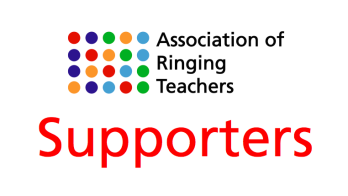
The ART Supporters programme provides a framework and benefits for those who support our work financially.
£5 per month or £50 per year
Package includes recognition on the Supporters page of the ART website, 25% off a ticket for the ART Conference, statement of our thanks posted on ART’s social media pages and an annual Supporter’s certificate.
£20 per month or £250 per year
All of the above, plus an extra ART Conference ticket at 25% off, the opportunity to host a stand at the ART Conference, and acknowledgement of thanks in Chairman’s Chatter.
£100 per month or £1000 per year
Package includes 50% off two tickets for the ART Conference. In additon to the benefits enjoyed by Friends and Sponsors, Patrons will be recognised on all ART Teaching Scheme and Learning the Ropes materials and certificates, and on every page of the ART website.
For regular payments by Standing Order.
You can often set up a Standing Order using online banking. Use these details.
Name: Association of Ringing Teachers
Sort Code: 30-90-89
Account Number: 36810368
Reference: please add your name
Otherwise you can use a paper form.
For one-off or monthly payments direct from your bank account.
Name: Association of Ringing Teachers
Sort Code: 30-90-89
Account Number: 36810368
Reference: please add your name
For one-off or monthly payments using a card or your paypal account.

Matt started ringing in Walsall as a teenager in the mid 1980’s when a school friend persuaded him to have a go. Although he has been ringing for over 30 years it is only since moving to Lilleshall, Shropshire in 2013 that he started (out of necessity) teaching people to ring. Building and developing the band at Lilleshall resulted in a particular interest in recruitment and retention.
Matt is currently the recruitment and retention lead for CCCBR’s Volunteer and Leadership Group and has helped develop the Recruitment and Retention Workshop in partnership with ART.

Taught to ring in Gloucestershire as a teenager, and now living and ringing in Hampshire after spending 40 years in London, Roger has held various posts on committees and as an officer within local ringing societies including Master of the London County Association. For a long time Roger was a member of the Central Council of Church Bell Ringers and served on its Ringing Centres, Towers & Belfries, Redundant Bells and Administrative Committees.
As a Chartered Surveyor, Roger combined his professional career with pleasure and played a leading role in major bell restoration projects at Bermondsey. Isle of Dogs, Limehouse, Rotherhithe and Walworth, as well as many smaller projects, and the transfer of redundant rings of bells from St Stephen Ealing to Aberdeen Cathedral and Homerton to Stone next to Dartford.
To help ensure there were adequate numbers of ringers to ring these restored bells, Roger turned his attention to issues of recruitment and training. Roger was a founder member of the Docklands Ringing Centre and Director of the former Ringing Foundation, which led to the establishment of ART. He was also a member of the review group (CRAG) which led to the current reforms of the Central Council.
Roger is currently a member of the ART Management Committee and an ART Tutor. He is also the owner of the Charmborough Ring and particularly interested in new initiatives to ensure that systems are in place to adequately follow up new ringers, and maximise retention, as well making more effective use of trainers through the use of simulators.

Dee learnt to ring in North Herts in the 70s as a teenager. She was very lucky to have a teacher who insisted on good handling and ringing with a gang of teenage bell ringers – they enjoyed lots of ringing based adventures!
Going to University in Nottingham to study Applied Chemistry, Dee joined NUSCR and was introduced to course bells, ringing surprise methods and ringing on higher numbers. She still maintains close links with the Society and was proud to hold the post of NUSCR President for 5 years.
In the 80’s Dee’s parents retired to Cornwall and during school holidays she had the privilege of ringing Call Changes with the local ringers and going on tour with the Cornish Choughs. She started her teaching career in the Midlands before finally settling to live in Burwell Cambs.
Dee is a very active ringer. As well as being the Burwell Tower Captain, she is the Ely DA Recruitment and Training Officer and Chair of Stretham REC. At the REC she enjoys the weekly Saturday morning teaching sessions with their buzzing atmosphere. The ART resources and her ART training are put to good use in her ringing activities.
With her teaching background, Dee finds being an ART Assessor extremely rewarding. She enjoys visiting different practices and guiding teachers and mentors. As a member of the ART Management Committee, she looks forward to supporting and developing the area of ART Assessment.

Clare learned to ring, aged 12, in the 1970s at Harborne in Birmingham and has rung there ever since. From a young age she began helping with teaching there, but it wasn’t until much later, when she became Tower Captain at Harborne, that she really developed her teaching skills.
A varied career began with 15 years making stained glass windows, followed by 19 years as a front-line paramedic with West Midlands Ambulance Service. Clare has just started a new venture, becoming a freelance First Aid Instructor.
In 2013 Clare came up with the crazy idea of a bell ringing school to centralise training in Birmingham and spread the load and responsibility of teaching, thereby supporting towers without teachers and distributing new ringers to towers within the St Martin’s Guild. Having presented the idea, she was surprised, but extremely grateful, that it was immediately supported by key figures in the Guild and thus the Birmingham School of Bell Ringing was born.
Involvement with ART came about in 2012, when one of the ringers at Harborne asked Clare to mentor her through Module 1 of the teaching course. Having attended the course and mentored several teachers Care became an ART Assessor and subsequently, in 2017, a Tutor for ART.

Arthur learned to ring as a teenager at his local tower, Theale, in West Berkshire. Following his time as a student at the University of York, He moved to Birmingham where he still lives and rings today. Arthur is a teacher by profession, with leadership responsibilities for curriculum and teacher development. He is thus excited to be working with ART as their Education Officer. Arthur believes that ringing teachers can learn from the wider research into educational pedagogy and has written a series of articles in the Ringing World on this topic.
Arthur has served as both Ringing Master and Secretary to the St Martin’s Guild. He has supported the development of the Birmingham School of Ringing as well as being an active supporter of ART since its inception.

Monica started ringing in 2017, having been inspired to have a go by Ringing Remembers. She was hooked from day one and quickly worked her way through the Learning the Ropes scheme, ringing her first quarter less than a year later and completing the scheme in just under two years. She attended the ART M1 day course in March 2022 and is now an accredited ART Member.
Monica has undertaken a number of voluntary roles in bellringing, including Administrator for the LtR Facebook group, Treasurer for the North West Ringing Course, Secretary of the LACR Fylde Branch and the Lancashire Lads & Lasses group. She is also Tower Secretary at her home tower, St. Anne’s-on-the-Sea, Lancashire.
After university, Monica spent 18 years working in IT, initially in technical roles, but quickly progressing to project and programme management. After taking four years out when her children were small, Monica has worked in schools for the past ten years, latterly as a secondary school Bursar. She is keen to use all the transferable skills she brings with her to benefit ART.

Lesley is Tower Captain of Swaffham Bulbeck, a tower of 8 bells, near Cambridge and has been ringing since she was a teenager. Although Lesley has rung all sorts over the years ranging from Doubles to Surprise Maximus, she says that one of the most fulfilling things she has done is to teach people.
Lesley has been an ART tutor for a few years now and has had the pleasure of introducing many people to the structured ART approach − no matter how experienced people have been at teaching handling when attending her courses, there has always been some very useful tips they have been able to take away with them, and ultimately some learner has benefited, giving Lesley so much satisfaction.

Like many ringers of a certain age Paul was a teenage starter − part of a completely novice young band brought together in 1977 by a newly installed rector to provide ringing at a near silent tower. This was at Pontesbury in mid-Shropshire, top end of the Hereford Diocesan Guild territory, and there he stayed (not making much progress) until a move to the University College of Wales in Aberystwyth. Paul initially didn’t ring at the single available tower in the locality (Llanbadarn Fawr) for fear that the student band would be too high-powered! However, he eventually plucked up courage and needn’t have been worried. This was really the start of his ringing commitment which has accompanied life ever since and a return back to Shropshire over 30 years ago.
Paul’s home tower is Edgmond, in the Shropshire Association, but he still retains links to the Hereford DG through ringing regularly at Much Wenlock. He is a committed member of the Welsh Colleges’ Society and is proud to be a member of the Cumberlands too. Paul had a period of eleven years as the Hereford DG’s Education Officer and places ringing training, teaching and education in his list of ringing priorities alongside local ringing commitments.
Residential ringing courses have been a mainstay of Paul’s ringing life and he has enjoyed student, helper and tutor roles at the Keele, Whirlow and Hereford Ringing Courses over many years. As a university senior lecturer, education, teaching and training are uppermost too in his professional work life – he has a passion about learning development, knowledge transfer and student engagement and is keen to bring these skills to ringing standards through ART and its work.

David learned to ring at St Michael’s Kirby-le-Soken at the age of 10. He was introduced to handbell ringing during his university studies at Imperial College, London by the late, great Roger Bailey and also given the opportunity to ring on 10 and 12 bells as part of the University of London band.
After university, 12-bell ringing continued under the guidance of George Pipe at St Mary-le-Tower, Ipswich. David served as Tower Captain at Kirby-le-Soken from 1985 to 1997. He is a past Master and and a Life Vice President of the Essex Association of Change Ringers and has been a regular tutor on the annual Essex Ringing Course since its foundation in 1991. In addition he has run a number of District and Association Training events over the years.
David was appointed as an ART Tutor in April 2019 and acts as the Tutor Coordinator.
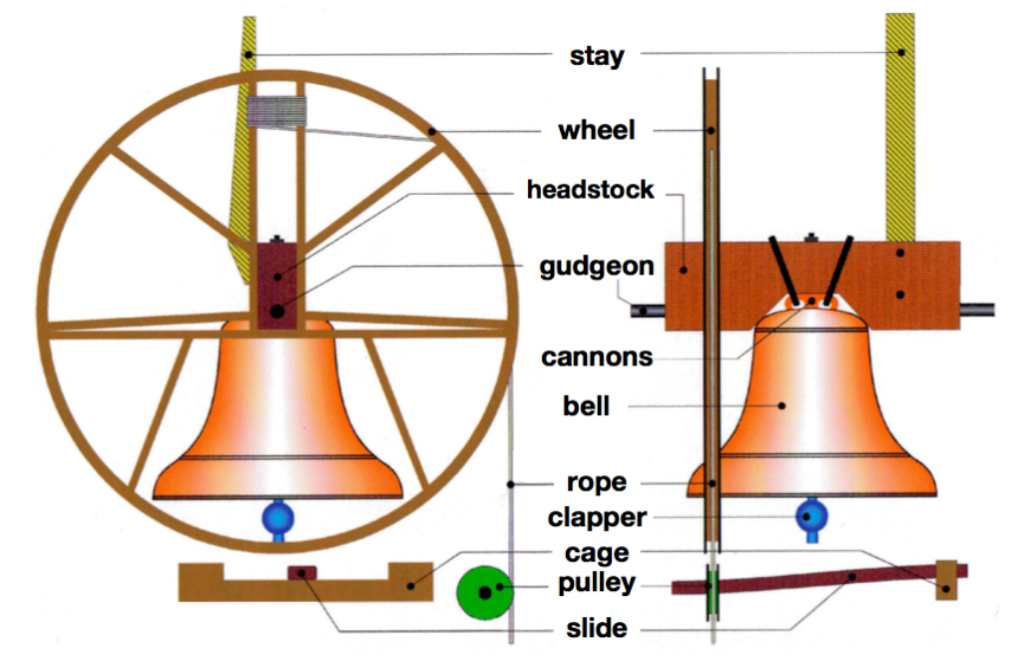
TESTING

Sue has been ringing since 2010 following an appeal in the local parish magazine. Four years later she was appointed Southern District Secretary of the Surrey Association, taking care of the membership records and preparing the accounts and annual report entries. Soon after she became Tower Captain of her local tower, St Margaret, Ockley.
Sue qualified as a chartered accountant in the 1980’s but gave it up a few years later due to family commitments and now lives on a smallholding, gardening on a large scale as well as running a walking group and acting as treasurer to a local charity.
Sue has been associated with ART since attending Module 1 in October 2015 and is ART’s Treasurer.

Annie grew up in a family where it was ringing on a Friday evening and a rugby match on Wednesday and so was set the pattern and passions of her life. She learnt to ring in Leicester and has spent time ringing in Staffordshire, Kent and Dorset. Currently she rings in Warwick, where the band rings at both towers.
Following a career in HR, Annie is now retired and spends much of her time with her family and helping with grandchildren. She is General Secretary of the Coventry Guild, a member of the Central Council and has been a member of ART since its inception.
Enjoying ringing and feeling part of a team are important for Annie and reflect the values she brings to her role as Secretary of ART.

Andrew joined the ART Management Committee as Chairman in 2023. Having worked in the university sector for over 30 years, Andrew brings an understanding of how to work through others and an in-depth experience of the world of quality assurance of education programmes and activities.
Whilst new to ART, Andrew has taught many people to ring, principally during his 28 years as Ringing Master of St. Mary’s Richmond, North Yorkshire, his home tower. He is a firm believer in theory and practice being necessary to develop ringers, and welcomes the opportunity to bring the skills and experiences of his work and his hobby to bear on the task of maintaining and developing bellringing through the Association of Ringing Teachers.